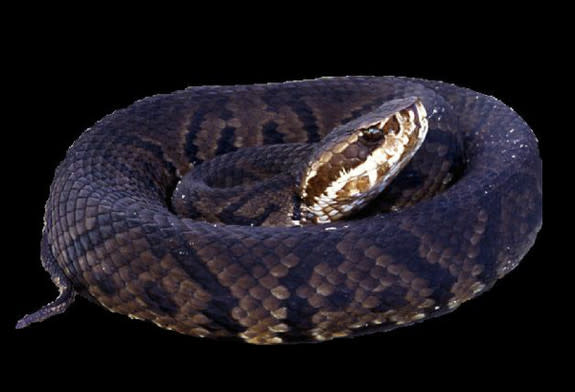Venomous Snakes Harbor Deadly Brain-Swelling Virus
Scientists had wondered how a mosquito-spread virus that causes the deadly brain-swelling disease Eastern equine encephalitis (EEE) — the one responsible for two deaths in Vermont this month — survives in eastern North America during the winter. Now, they think they know the virus's keeper: snakes.
Previous work has implicated these reptiles, and the most recent study has found not only antibodies against the virus, but also genetic material from the virus itself in two species of venomous snakes living in Alabama.
"This paper is the final nail in the coffin that indicates that snakes are involved in this whole process," said Thomas Unnasch, a professor and chair of the University of Southern Florida's global health department.
Snakes appear to be the wintertime counterpart to birds, which catch the virus from mosquitoes and host it through the summer.
Mosquitoes can also spread the virus to humans with rare, but potentially devastating consequences. About six human cases of the disease the virus causes are reported in the United States every year. EEE causes a brain inflammation and can kill its victims or leave them with severe brain damage, according to the U.S. Centers for Disease Control and Prevention. The disease also affects other animals, particularly horses. [10 Deadly Diseases That Hopped Across Species]
Unnasch and colleagues checked the blood of snakes caught in Alabama's Tuskegee National Forest for antibodies against the virus and also for the genetic code of the virus.
Antibodies, proteins the immune system produces as part of its defense against an invader, are evidence the snakes have been exposed to the virus. Meanwhile, the presence of the virus itself means the snakes have an infection.
Of the 73 snakes from eight species tested over three years, about 15 percent had EEE infections and about twice as many had antibodies. Most of these were cottonmouth snakes, by far the most abundant snake in the area, with a few copperheads, both of which are venomous. (Only one copperhead was positive for the virus, though others showed EEE antibodies.)
These results indicate that a relatively high proportion of wild snakes are infected with the virus and maintain it in their blood at the study site and most likely elsewhere, he said.
The team collected blood from the snakes from April through September, 2007 through 2009. Among 54 cottonmouths sampled, the infection rate peaked in April, just as the snakes were emerging from hibernation.
The virus doesn't appear to sicken the snakes, Unnasch said,adding, "They don't seem to have an effective immune response; the antibodies they produce don't seem to inactivate the virus."
This works to the virus's advantage. Experiments in Unnasch's laboratory indicated the snakes could harbor the virus in their blood for longer periods than birds, the virus's summertime host. When they induced the snakes to hibernate, Unnasch and colleagues found the virus persisted in the snakes' blood at low levels throughout hibernation. They suspect this happened because the snakes' metabolism and immune system slowed and so the snakes weren't able to rid themselves of the viral particles.
Research so far suggests mosquitoes may be picking up the virus from snakes early in the year, as soon as the hibernating snakes first leave their dens to bask. From there, the mosquitoes transmit it to birds, Unnasch said.
This information points to a better way to fight the spread of the disease, he said.
Currently, efforts to fight the virus involve attempts to eradicate mosquitoes once infections have already begun showing up among animals, particularly horses, much later in the season. But at this point, the virus is typically widespread among summer mosquito populations.
Instead, it would may make more sense to apply much smaller, more targeted insecticide treatments against those species of mosquitoes that emerge early in the year to feed upon the snakes, he said.
The study was published online today (Oct. 1) in the journal American Journal of Tropical Medicine and Hygiene.
Follow LiveScience on Twitter @livescience. We're also on Facebook & Google+.
Copyright 2012 LiveScience, a TechMediaNetwork company. All rights reserved. This material may not be published, broadcast, rewritten or redistributed.



